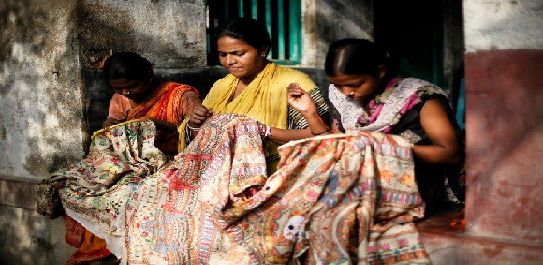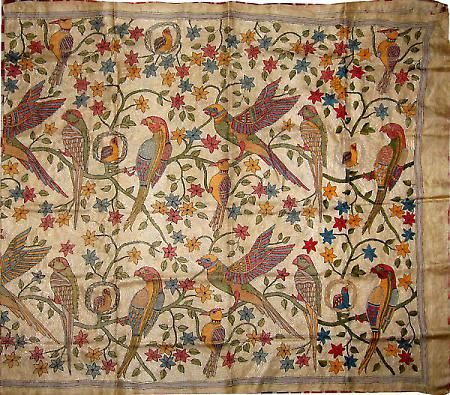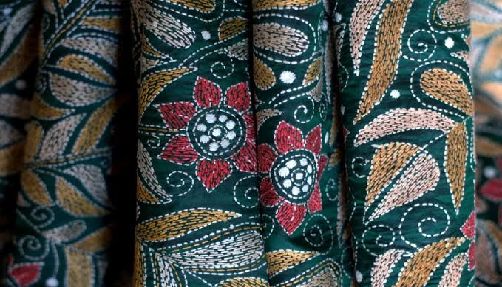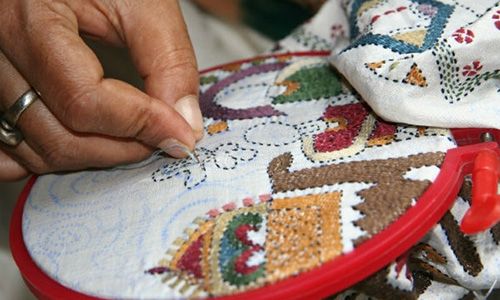Kantha Embroidery
Sep 21, 2019 • 251 views
Origin of the Embroidery
Originated in the eastern parts of the Indian subcontinent, Kantha embroidery which is also spelled as Kanta or Qanta has its history arching back to first and second AD, thus making it one of the oldest forms of embroidery in India. To talk in figures and facts, 500 years old art form whose mention can be found in Krishnadas Kaviraj's book 'Chaitanya Charitamrita' is what will be the description about its existence. It is most significant in states like West Bengal, Tripura, Odisha and the neighboring country of Bangladesh.
Method and Varieties
The word Kantha carries the meaning 'rags' in Sanskrit, thus indicating towards its nature of being an embroidery done on discarded clothes and garments that are stitched together to form something productive.

Women together doing Kantha embroidery- Source: Textiles Of India
Authentically, born out of need and necessity, this embroidery was done by using colorful threads taken from old saris and clothes. In the present time however any kind of colorful thread can be used. The next thing about this embroidery is its weaving technique. One of the most simplest stitch - the running stitch is used in this kind of embroidery, which is basically passing of the needle in and out of the fabric. Despite the use of such simple stitch, kantha embroidery in itself is nowhere as simple and easy as it sounds. Some of the basic steps in this embroidery include -
The very first step in Kantha embroidery is to sketch the design of the embroidery which includes figures, motifs and other intricate details on a tracing paper.
Next, this design is transferred onto the base of the fabric. Since the designs are quite complicated it is always prefered to colour the traced designs so as to make it easier for the artisan while weaving.
Now starts the final and the most difficult part of this embroidery i.e., filling the designs with running stitches. In this the artisans have to very carefully manipulate the stitch to create the desired design. This also results in a wrinkly and wavy effect on the fabric.
There are basically seven types of Kantha depending on their use-
ARSHILATA- This kind of Kantha is used to prepare covers for toiletries such as comb, brush, mirrors etc. Its design include wide borders and colorful motifs.
BAYTON- This is used to produce book covers and wraps for other valuable item. Often carried while travelling, they showcase elaborate designs made of multicolored threads.

Bayton Kantha- Source: Strands Of Silk
DURJANI- Generally used to make a wallet, its three corners are stitched together in the centre with the fourth one being left out as a flap. Broad, intricately designed borders with a lotus in between are its characteristic features.
LEP KANTHA- This is basically a wrap, rectangular in shape used to make quilts by placing a number of saris one over the other. It usually showcases simple geometrical designs.
OAR KANTHA- Oar also spelled as ooar is used to make pillow covers and carries simple designs like trees,birds, creepers etc.
SUJANI KANTHA- It is the most famous design out of all other kantha designs. It is particularly used to make bedcovers and spreads for auspicious occasions.
RUMAL KANTHA- It is the smallest of all kanthas. Its characteristics include elaborately designed borders with simple central motifs like lotus and animals. It is generally used as a household wipe.
Themes, Inspiration and Religious Significance
Kantha embroidery derives its inspiration from day to day activities and elements from the surroundings. The designs incorporate elements of nature such as birds, flowers, leaves, trees, sun, animals etc. Folk scenes also acted as a medium to take reference from, in Kantha embroidery. Motifs in Kantha embroidery differ according to the people who make it. For example the Hindu Kantha embroidery uses motifs like lotus, swastika and the wheel of life. In case of Muslim Kanta, elements like star, pinch(tara chutki), stick(laathi), mirror, hair buns(aina khopa) are majorly used as motifs.

Flora and Fauna Inspired Kantha Embroidery- Source: Utsavpedia
A number of religious stories are attached to Kantha embroidery. One such story is related to Lord Shiva according to which during Samudra Manthan he drank poison in order to protect the world and Goddess Parvati in order to prevent that poison from dropping into his stomach that contains the universe, strangled him with her hands. This resulted in his throat turning blue and this established the connection between kantha embroidery and this tale due to the fact that the word 'kantha' also means 'throat'.
Faces Behind the Embroidery
Originally, Kantha embroidery was done by rural housewives and the technique passed onto their daughters as a hereditary tradition of passing down the folk craft from one generation to another. Due to it not being taught and expanded on a greater level, it slowly started fading away until a few people made efforts to revive this beautiful art. One such person who has done commendable work in this section is Shamlu Dudeja who founded the Self Help Enterprise in 1980s and promoted the art form by motivating women to take up the craft as a method to empower themselves.
Present Day Scenario
Kantha embroidery has very successfully made its place in the contemporary times and has established itself as a major traditional art form. Due to its versatile nature and multiple uses, it attracts people from various sectors. From the local people to well-known personalities like Hillary Clinton, this embroidery has been successful in impressing everyone. Nowadays it's being used in different ways such as on dhotis, kurtas, Sherwanis, Hot pants, Skirts etc. With every passing day, some or the other experiment in this sector happens, whether it is with reference to style, medium or design, Kantha embroidery keeps on evolving and adapting itself with the current times.

Modern Kantha Embroidery- Source: Strands Of Silk
Kantha and Globalization
In the present scenario, globalization is the way to keep any art form alive and trending. And when it comes to Kantha embroidery it is doing exactly that. Not only in India, but in other countries like USA and Japan, the demand for Kantha is constantly growing. Use of Kantha by famous designers and increase of e-commerce platforms which support and promote local art forms, all have helped in globalizing Kantha embroidery.

Kantha Embroidery on Saree Fabric- Source: Unnati Silks

